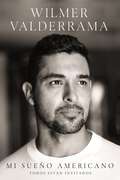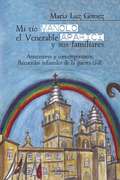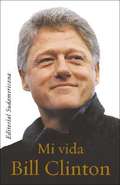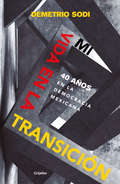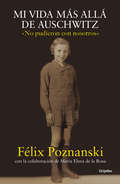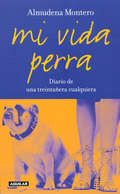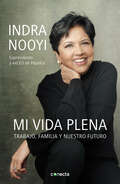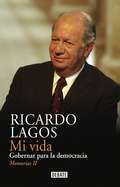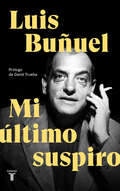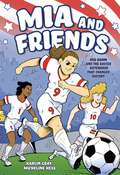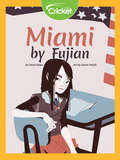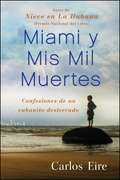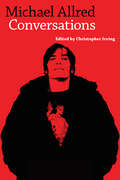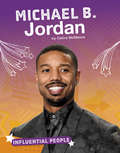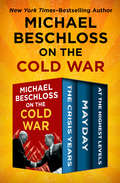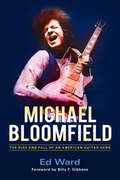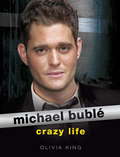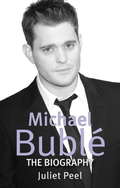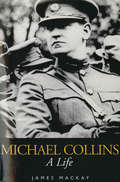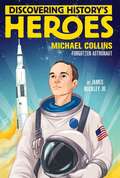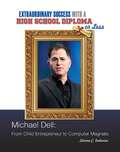- Table View
- List View
Mi ruido azul
by Marina JadeMarina Jade, la maravillosa exintegrante de Operación Triunfo, nos cuenta su vida. Me llamo Marina, mi nombre artístico es Marina Jade, y en estas páginas te voy a contar, en resumidas cuentas, mi vida. Desde mi infancia -cuando era «la gordita», «la empollona», «la de los brackets»- hasta que la música me salvó y se convirtió en mi felicidad. Aquí te explicaré lo importantes que son para mí mi familia y mis seres queridos, cómo salí del armario, lo que significa sufrir LGBTfobia y también cómo me sentí al cumplir el sueño de participar en Operación Triunfo. Bienvenida a mi libro. ¡Bienvenida a mi ruido azul!
Mi sueño americano: Todos están invitados
by Wilmer ValderramaMi sueño americano es el conmovedor libro de memorias del actor, productor y activista Wilmer Valderrama, que ahonda en su educación en Venezuela, donde fue criado por dos padres muy trabajadores, mientras su familia atravesaba un país en rápida transformación y el ascenso de Hugo Chávez.Con la economía derrumbándose a su alrededor y su medio de vida desapareciendo, la familia decide huir del país. De repente, el niño al que le encantaba montar a caballo y soñar con ser el Zorro de su serie favorita de televisión en blanco y negro, tuvo que crecer rápidamente y viajó, siendo un adolescente, desde un pequeño pueblo de Venezuela a la gran ciudad de Los Ángeles.En los años siguientes, Valderrama crearía el exitoso programa Yo Mamma, deleitaría a los niños con Handy Manny, pondría voz al personaje principal de Encanto de Disney y mucho más, hasta unirse al reparto del exitoso programa NCIS en 2016.Sin embargo, fue a través del servicio a los demás y de su primer viaje con United Service Organization (USO por sus siglas en inglés) donde Valderrama encontró su vocación ampliada, entreteniendo y animando a las tropas estadounidenses en todo el mundo. De repente, quiso hacer todo lo que pudiera, dedicando su tiempo y sus esfuerzos a retribuir al país que considera su hogar.A través de su trabajo, Valderrama espera demostrar su amor y su gratitud por el país que cambió su vida. Mi sueño americano entrelaza las historias personales de Valderrama con las de personas notables que ha conocido a lo largo de su viaje filantrópico. Sin embargo, esta no es solo la historia de Valderrama, sino también una visión de Estados Unidos de América a través de los ojos de un inmigrante, tanto en sus asombrosas maravillas inigualables como en todos sus retos. Es la historia profunda y apasionante de alguien que encontró el camino y ahora invita a cuantos sea posible a acompañarle en la aventura.An American StoryAn American Story is the stirring memoir by actor, producer, and activist Wilmer Valderrama, delving into his upbringing in Venezuela where he was raised by two hard working parents as they navigated their family through a rapidly changing country and the rise of Hugo Chavez. With the economy crashing around them and their livelihood disappearing, the family decides to flee the country. Suddenly, the young boy who had loved riding his horse and dreaming of being Zorro from his favorite black and white tv show had to grow up quickly, journeying as a teenager from a tiny little pueblo in Venezuela to the big city of Los Angeles.It was through service to others and his first USO trip, however, where Valderrama found his expanded calling, entertaining and encouraging U.S. troops around the world. Suddenly, he wanted to do as much of this as he could, dedicating his time and efforts to giving back to the country he calls home.Through his work, Valderrama hopes to demonstrate his love and gratitude for the country that changed his life. An American Story weaves Valderrama&’s personal stories with those of the remarkable people he&’s met along his philanthropic journey. This isn&’t just Valderrama&’s story, though. It&’s a view of America through an immigrant&’s eyes, in both its stunning unmatched wonders and all of its native challenges. It is the profound and gripping story of someone who found the way and is now inviting as many as possible to join him on the adventure.
Mi tío Manolo, el Venerable Aparici y sus familiares: Antecesores y contemporáneos. Recuerdos infantiles de la Guerra Civil
by María Luz GómezEn nuestro árbol genealógico, la estrella de mayor magnitud en la brillante rama de los Aparici, es Manuel. <P><P>Este libro comprende una breve biografía de mi tío, Manuel Aparici, que se encuentra en proceso de beatificación y canonización, y ya ha sido declarado por la Iglesia Venerable. Esto equivale a decir que «el siervo de Dios, cuya vida se estudia, ha practicado virtudes heroicas y es propuesto como modelo e intercesor». <P><P>También hablo de algunos de nuestros antepasados interesantes de la rama Aparici y familiares contemporáneos. Igualmente, relato referencias históricas de la época, además de mis recuerdos infantiles (tenía de cuatro a siete años) de nuestra española Guerra Civil. <P><P>Conmemoro las peregrinaciones al Pilar (en el año jubilar en el que se celebró el 1900 centenario de la venida de la Virgen en carne mortal a Zaragoza, que capitaneó Manolo personalmente), y a Santiago de Compostela (que solo pudo hacerlo espiritualmente), en cuya preparación con tanto entusiasmo y esfuerzo trabajó. Y termino con su muerte «en loor de santidad».
Mi vida
by Bill Clinton"Mi vida", del presidente Clinton, es un impresionante y sorprendentemente honesto retrato de un líder global que decidió cuando era joven que dedicaría sus dotes intelectuales y políticas, y su extraordinaria capacidad para el trabajo duro, al servicio de los ciudadanos. Nos muestra la trayectoria de un americano notable que, gracias a su enorme energía y esfuerzo, logró realizar el improbable viaje desde Hope, Arkansas, hasta la Casa Blanca, un trayecto alimentado por el apasionado interés en el proceso político que manifestó en cada etapa de su vida: en la universidad, trabajando como becario para el senador William Fulbright; en Oxford, cuando formó parte del movimiento de protesta contra la guerra de Vietnam; en la facultad de Derecho de Yale, haciendo campaña a nivel de base para los candidatos demócratas; y de nuevo en Arkansas, cuando se presentó como candidato al Congreso, a fiscal general y al cargo de gobernador. A lo largo de esta obra, somos testigos de cómo su carrera política se forjó a partir de un compromiso firme con el avance de los derechos civiles y de una excepcional capacidad de comprender los detalles prácticos, de la vida política. El libro del presidente Clinton es también la narración más completa, matizada y con más detalles concretos de una presidencia, pues no solo abarca los momentos más destacados de las crisis, sino también la manera en que la presidencia funciona realmente: el bombardeo cotidiano de problemas, personalidades, conflictos, reveses y éxitos." (Tomado de Cúspide libros)
Mi vida en la transición: 40 años en la democracia mexicana
by Demetrio SodiEn un momento en el que se ha reconfigurado todo el mapa político del país, resulta imprescindible recordar la historia de la transición en México, para entender que no existen soluciones mágicas y que ignorar lo avanzado durante años puede representar un retroceso generacional. Decía Julio Scherer García que para entender la historia hay que analizar a los protagonistas. Y esta obra hace justamente eso: Demetrio Sodi, uno de los mayores conocedores de la política mexicana desde hace décadas, nos guía por los salones y los despachos donde se ha decidido la vida del país durante los últimos 40 años. Sodi de la Tijera —quien ha sido jefe delegacional, diputado, senador y activista, entre otros— nos cuenta los entresijos de las negociaciones, las tensiones ocultas, las amenazas, las razones hondas y las anécdotas más reveladoras. En un viaje que va desde Echeverría hasta López Obrador, retrata a Cuauhtémoc Cárdenas, López Portillo, Carlos Salinas, el sub Marcos y buena parte de la clase que hoy gobierna.
Mi vida más allá de Auschwitz: No pudieron con nosotros
by Félix Poznanski María Elena de la RosaMi abuelo siempre decía que el ser humano tiene la capacidad de olvidar, pero yo tenía la necesidad de saber qué era aquello que él no quería recordar. «Me paré sobre los lugares donde millones de personas vivieron la tragedia. Intenté imaginarme todo el espanto, la masacre... Y pensé en mi abuelo, un niño de tan sólo 8 años, separado de su familia, siendo completamente torturado. A diferencia de mí, que entré sin que nadie me obligara y con la libertad de salir cuando quisiera. Me sentí orgullosa de mi abuelo pero al mismo tiempo imponente, triste y con mucho enojo. Vine para tratar de entender cómo pudo ser posible, y me quedo con más dudas todavía. Vine en honor a mi abuelo que logró sobrevivir y, sobre todo, para demostrar que realmente no pudieron con nosotros». Tatiana Poznanski, Auschwitz 2019
Mi vida perra: Diario de una treintañera cualquiera
by Almudena MonteroMi vida perra es una sucesión de textos tan directos y vivos como el día a día que reflejan. Tan sorprendentes y cambiantes como las formas de relación en la nueva era de internet. «Lo malo de vivir sola es que pasas demasiado tiempo mirándote la bragueta. Y cuando observas mucho algo, no suele gustarte demasiado. Entonces te regañas, te peleas contigo misma, te largas con el perro dando un portazo, o mejor al cine y así no tienes que seguir escuchándote. Al salir, te apetece hablar con alguien, pero a ver a quién le cuentas que ya no te soportas, que no puedes más, o que te vas a separar de ti misma por culpa de tus problemas de convivencia.» Los textos de Mi vida perra han sido extraídos del blog de Almudena Montero, escritora y guionista que un día decidió compartir su intimidad a través de la pantalla de su ordenador. Durante unos meses nos infiltramos en su apartamento y asistimos a cuanto vive, piensa, desea o tan solo imagina. La soledad, el desencuentro con la pareja, el sexo casual, los amigos de toda la vida, los paseos con su perro Baldo o las crisis de identidad ocupan estas páginas, teñidas de ironía ácida y de un sentido del humor iconoclasta.
Mi vida plena: Trabajo, familia y nuestro futuro
by Indra NooyiUn íntimo y poderoso libro de memorias de la pionera ex-CEO de PepsiCo Durante sus doce años como una de las más admiradas CEO del mundo, Indra Nooyi redefinió lo que significa ser un líder excepcional. La primera mujer de color e inmigrante en dirigir una de las 50 compañías más importantes listadas por Fortune y una de las estrategas más destacadas de nuestro tiempo transformó PepsiCo con una visión única, una vigorosa búsqueda por la excelencia y un gran sentido del propósito. En sus memorias nos cuenta con gracia, valor y buen humor su legendaria carrera y los sacrificios realizados. Nooyi nos lleva a través de los eventos que la forjaron desde su infancia y primeros años de escuela en la India de 1960, pasando por la Escuela de negocios de Yale, hasta su ascenso como consultora y estratega que pronto alcanzó el más alto de los puestos ejecutivos. El libro ofrece una mirada al interior de PepsiCo y cómo, durante su liderazgo, Indra logró reinventar la imagen de una de las empresas más icónicas de Estados Unidos, a través de productos sanos y un enfoque en el medio ambiente, a pesar de la resistencia que enfrentó en todo momento. Por primera vez y con lujo de detalles, Indra también comparte las dificultades que afrontó al compaginar su demandante trabajo con una familia en ciernes y las grandes lecciones que aprendió en el camino. Ella hace una llamada clara y urgente a las empresas y a los gobiernos a priorizar ecosistemas de cuidado, licencias con goce de sueldo y flexibilidad laboral. Sostiene que mejorar las empresas y el apoyo comunitario a las familias jóvenes liberará el potencial económico que todos deseamos. Generosa, imperativa y basada en experiencias reales, Mi vida plena es la historia de una extraordinaria líder, un tributo a lasrelaciones que la crearon y una huella para la prosperidad del siglo xxi. “Rara vez se tiene la oportunidad de ver cómo se moldea una líder de la talla global de Indra K. Nooyi. Indra comparte sus aprendizajes, su desarrollo, la evolución de su pensamiento con una generosidad y transparencia sin igual. Corre la cortina y deja entrar al lector a su vida. Una biografía única de una mujer sin igual.” -Paula Santilli, CEO PepsiCo Latino América
Mi vida. Memorias II: Gobernar para la democracia
by Ricardo LagosLa continuación de las notables memorias del presidente Lagos, desde octubre de 1988 hasta el final de su mandato presidencial. Estas memorias narran los momentos fundamentales de la vida política del ex presidente Ricardo Lagos, desde el retorno de la democracia hasta el final de su gobierno, relatando los pormenores de los primeros veinte años de transición política, pasando por su rol los gobiernos de Aylwin y Frei, sus exitosos años de gobierno y el rol que tuvo Chile tanto en el escenario latinoamericano como internacional. Se trata de un libro en que narrativa y reflexión, memoria y análisis crítico se imbrican, proyectando una mirada contundente y muy necesaria sobre el país del pasado, del presente y también el del futuro. Incluirá un cuadernillo de fotos que acompañan y enriquecen el relato biográfico de una figura clave para entender el Chile de las últimas décadas.
Mi último suspiro
by Luis BuñuelUn libro de memorias canónico, fruto de dieciocho años de trabajo y de la amistad entre el genial cineasta y Jean-Claude Carrière. Estas memorias son el fruto de dieciocho años de trabajo y amistad entre Luis Buñuel y Jean-Claude Carrière. Juntos hicieron seis obras maestras del cine: Diario de una camarera, Belle de jour, La Vía Láctea, El discreto encanto de la burguesía, El fantasma de la libertad y Ese oscuro objeto del deseo. El libro nació espontáneamente de sus entrevistas en España y México durante los intervalos de las sesiones de trabajo; el uno evocando sus recuerdos y el otro recogiendo las palabras del amigo y anotándolas. Mi último suspiro recoge la voz y las propias palabras de Luis Buñuel, y nos da una particular visión del genial cineasta y de su mundo más personal. Esta edición conmemora el trigésimo aniversario de su primera edición francesa y española. Reseña:«Buñuel es el portador de una conciencia poética.»Andrei Tarkovski
MiG Pilot: The Final Escape of Lieutenant Belenko
by John BarronTells of the life of Lieutenant Viktor Ivanovich Belenko in Tokyo, Moscow and Tokyo and his secrets in regards to the Soviet Union.
Mia and Friends: Mia Hamm and the Soccer Sisterhood that Changed History
by Karlin GrayBased on the true story of soccer legend Mia Hamm, Mia and Friends follows a group of young women who made history at the 1999 Women’s World Cup!Despite being named after a famous ballerina, little Mia Hamm never cared for pirouettes. Instead, she chased the ball: baseball, basketball, and especially soccer. Since she was often the only girl on her sports teams, she had a hard time making friends. But when fifteen-year-old Mia made the U.S. women’s national soccer team, everything changed. All around her, young women tackled and dribbled, passed and kicked, scored, and screamed. They were just like her—but even more skilled. For Mia to improve, she had to play up to the levels of Michelle Akers, Briana Scurry, Brandi Chastain, and so many others. She was determined not to let her team down.
Miami by Fujian
by David Kwee Gloria PizzilliMariel is a young girl who is struggling with her identity. As a Chinese-American being raised by her adoptive Latino family in Miami, she doesn't understand who she really is. All of the other kids make fun of her but Mariel feels connected to her Latino culture. After a trip to China, where she was born, Mariel learns about her Chinese heritage. Seeing the orphanage and all the children who are still up for adoption allow Mariel to be happy with her life. She is finally able to accept who she really is—a "Florida chica china by the way of Fujian!"
Miami y Mis Mil Muertes: Confesiones de un cubanito desterrado
by Carlos EireEn su libro de memorias Nieve en La Habana, el cual ganó el Premio Nacional del Libro en 2003, Carlos Eire narra su niñez en Cuba en la época del triunfo de la revolución y la llegada al poder de Fidel Castro. Esa historia termina en 1962, en el avión que lleva a Carlos y a su hermano desde La Habana a Miami para comenzar una nueva vida, como sucedió a miles de niños cubanos. Pasarían años antes de que Carlos volviera a ver a su madre. Y nunca más volvería a ver a su padre, por quien sentía una verdadera devoción. Miami y Mis Mil Muertes sigue el cuento en el momento en que aquel avión aterriza y Carlos comienza una nueva vida impulsado por sus miedos y esperanzas. Enseguida se da cuenta de que para llegar a ser americano tendrá que "morir" el Carlos cubano que hasta ahora ha sido. Se enfrenta al eterno dilema del inmigrante que debe aprender inglés, ir a una escuela americana y descifrar un futuro incierto: está en el país de las oportunidades, pero aún no es capaz de aprovecharlas. A pesar de la dura realidad de los hogares adoptivos donde ha de vivir, el muchacho se abre paso, dejando atrás cualquier vestigio de su vida pasada hasta el punto de cambiar su nombre y convertirse en Charles. Miami y Mis Mil Muertes es un exorcismo y una oda a esa experiencia, es un homenaje a la renovación, a los momentos de la vida en que tenemos la certeza de haber muerto y, de alguna manera milagrosa, haber vuelto a nacer.
Michael Allred: Conversations (Conversations with Comic Artists Series)
by Christopher IrvingMichael Allred (b. 1962) stands out for his blend of spiritual and philosophical approaches with an art style reminiscent of 1960s era superhero comics, which creates a mixture of both postmodernism and nostalgia. His childhood came during an era where pop art and camp embraced elements of kitsch and pastiche and introduced them into the lexicon of popular culture. Allred's use of both in his work as a cartoonist on his signature comic book Madman in the early 1990s offset the veiled autobiography of his own spiritual journey through Mormonism and struggles with existentialism. Thematically, Allred's work deals heavily with the afterlife as his creations struggle with the grander questions—whether his modern Frankenstein hero Madman, cosmic rock 'n' roller Red Rocket 7, the undead heroine of iZombie (co-created with writer Chris Roberson), or the cast of superhero team book The Atomics. Allred also enjoys a position in the creator-driven generation that informs the current batch of independent cartoonists and has experienced his own brush with a major Hollywood studio's aborted film adaptation of Madman. Allred's other brushes with Hollywood include an independent adaptation of his comic book The G-Men from Hell, an appearance as himself in Kevin Smith's romantic comedy Chasing Amy (where he provided illustrations for a fictitious comic book), the television adaptation of iZombie, and an ongoing relationship with director Robert Rodriguez on a future Madman film. Michael Allred: Conversations features several interviews with the cartoonist from the early days of Madman's success through to his current mainstream work for Marvel Comics. To read them is to not only witness the ever-changing state of the comic book industry, but also to document Allred's growth as a creative genius.
Michael B. Jordan (Influential People)
by Celina McManusActor Michael B. Jordan is known for connecting with his characters, including playing the villain in the Hollywood blockbuster Black Panther. Learn more about his rise to fame!
Michael Beschloss on the Cold War: The Crisis Years, Mayday, and At the Highest Levels
by Michael Beschloss Strobe TalbottRiveting accounts of the Cold War power struggles from the New York Times–bestselling author and “nation’s leading presidential historian” (Newsweek). The Crisis Years: A national bestseller on the complex relationship between President John F. Kennedy and Soviet Premier Nikita Khrushchev, this “definitive” history covers the tumultuous period from 1960 through 1963 when the Berlin Wall was built, and the Bay of Pigs invasion and the Cuban Missile Crisis brought the United States and Soviet Union to the brink of nuclear war (David Remnick, The New Yorker). “Impressively researched and engrossingly narrated.” —Los Angeles Times Mayday: On May Day 1960, Soviet forces downed a CIA U-2 spy plane flown by Francis Gary Powers, two weeks before a crucial summit. This forced President Dwight Eisenhower to decide whether to admit to Nikita Khrushchev—and the world—that he had secretly ordered the flight. Drawing on previously unavailable CIA documents, diaries, and letters, as well as the recollections of Eisenhower’s aides, Beschloss reveals the full high-stakes drama. “One of the best stories yet written about just how those grand men of diplomacy and intrigue conducted our business.” —Time At the Highest Levels: Cowritten with Strobe Talbott, At the Highest Levels exposes the complex negotiations between President George Bush and Soviet Premier Mikhail Gorbachev. In December 1989, the Berlin Wall had fallen, millions across the Eastern Bloc were enjoying new freedoms, and the USSR was crumbling. But a peaceful end to the Cold War was far from assured, requiring an unlikely partnership, as the leaders of rival superpowers had to look beyond the animosities of the past and embrace an uncertain future. “Intimate and utterly absorbing.” —The New York Times
Michael Bloomfield: The Rise and Fall of an American Guitar Hero
by Billy Gibbons Ed WardThis is the definitive biography of the legendary guitarist whom Muddy Waters and B. B. King held in high esteem and who created the prototype for Clapton, Hendrix, Page, and those who followed. Bloomfield was a member of the Paul Butterfield Blues Band, which inspired a generation of white blues players; he played with Bob Dylan in the mid-1960s, when his guitar was a central component of Dylan's new rock sound on "Like a Rolling Stone." He then founded the Electric Flag, recorded Super Session with Al Kooper, backed Janis Joplin, and released at least twenty other albums despite debilitating substance abuse. This book, based on extensive interviews with Bloomfield himself and with those who knew him best, and including an extensive discography and Bloomfield's memorable 1968 Rolling Stone interview, is an intimate portrait of one of the pioneers of rock guitar.
Michael Buble: Crazy Life
by Olivia KingThe long-awaited illustrated biography of Michael BubleMichael Buble is the most successful male artist in the world at the moment. Born in British Columbia to a family of Italian fishermen, music is in the family blood and it was Michael's grandfather first introduced him to the kind of music he would later make his own - Frank Sinatra, Ray Charles, Dean Martin and Elvis. Since his debut in 2003, he has sold 25 million albums, won two Grammys and multiple Junos, reached the top 5 in countries around the world as well as numerous number 1s, his concerts have been sell outs and he has cultivated a huge and loyal fanbase. Michael Buble is a music phenomenon and this beautifully designed biography will celebrate his success. Packed with stunning photographs and lavishly designed spreads charting his story - both personal and professional - and his meteoric rise to stardom, this book is a must-have for the millions of Michael Buble fans around the world.
Michael Buble: Crazy Life
by Olivia KingThe long-awaited illustrated biography of Michael BubleMichael Buble is the most successful male artist in the world at the moment. Born in British Columbia to a family of Italian fishermen, music is in the family blood and it was Michael's grandfather first introduced him to the kind of music he would later make his own - Frank Sinatra, Ray Charles, Dean Martin and Elvis. Since his debut in 2003, he has sold 25 million albums, won two Grammys and multiple Junos, reached the top 5 in countries around the world as well as numerous number 1s, his concerts have been sell outs and he has cultivated a huge and loyal fanbase. Michael Buble is a music phenomenon and this beautifully designed biography will celebrate his success. Packed with stunning photographs and lavishly designed spreads charting his story - both personal and professional - and his meteoric rise to stardom, this book is a must-have for the millions of Michael Buble fans around the world.
Michael Buble: The Biography
by Juliet PeelMichael Bublé is an international singing sensation. Since his debut in 2003, he has sold 18 million albums, won numerous awards (including a Grammy), reached the top 10 in the UK charts with his first album, 'Michael Bublé', and the top 50 of the Billboard 200 album charts for the same CD. His second album, 'It's Time', was more successful still, debuting at number 4 in the UK charts, and his song 'Home' was a UK number one. His performances and concerts worldwide have been sell outs, while he has cultivated a huge and loyal fanbase. Of Italian origin, and born into a family of fishermen in Canada, Michael was heavily influenced by his grandfather, whom he credited with introducing him to the kind of music he would make his own - Frank Sinatra, Ray Charles, Dean Martin and Elvis, to name but a few. His popularity continues to grow, and this comprehensive and definitive biography charts his fascinating and phenomenal success story.
Michael Buble: The biography
by Juliet PeelMichael Bublé is an international singing sensation. Since his debut in 2003, he has sold 18 million albums, won numerous awards (including a Grammy), reached the top 10 in the UK charts with his first album, 'Michael Bublé', and the top 50 of the Billboard 200 album charts for the same CD. His second album, 'It's Time', was more successful still, debuting at number 4 in the UK charts, and his song 'Home' was a UK number one. His performances and concerts worldwide have been sell outs, while he has cultivated a huge and loyal fanbase. Of Italian origin, and born into a family of fishermen in Canada, Michael was heavily influenced by his grandfather, whom he credited with introducing him to the kind of music he would make his own - Frank Sinatra, Ray Charles, Dean Martin and Elvis, to name but a few. His popularity continues to grow, and this comprehensive and definitive biography charts his fascinating and phenomenal success story.
Michael Collins: A Life
by Dr James MackayThe most charismatic figure to emerge during the struggles for the independence of Ireland was undoubtedly Michael Collins. This remarkable biography, which draws on much hitherto unpublished material, charts the dramatic rise of the country boy who became head of the Free State and the commander-in-chief of the army.
Michael Collins: Discovering History's Heroes (Jeter Publishing)
by James Buckley Jr.Jeter Publishing presents the second nonfiction biography in a brand-new series that celebrates men and women who altered the course of history often without recognition. On July 16, 1969, a Gemini rocket lifted off from Kennedy Space Center in Florida. Previous launches had focused on getting astronauts into space, docking two spacecraft, and even walking in space, but this mission was different. Apollo 11 was designed to land two astronauts on the moon and then bring them back to Earth. Four days later, two astronauts, Neal Armstrong and Buzz Aldrin, did walk on the moon. But did you know that there were actually three astronauts aboard the rocket on July 16? Michael Collins didn’t get to walk on the Moon, but his contribution is just as important as Armstrong and Aldrin’s. Prior to joining NASA, Collins was in the Air Force and flew fighter jets. After joining NASA, he made two trips into space, performing one of the first EVAs or Extravehicular activities (in other words, walking in space) as well as making that trip to the moon. Collins continued to contribute even after leaving the space program. He took a job in the State Department and even served as director of the National Air & Space Museum and as undersecretary of the Smithsonian Institution in Washington, DC. He may not have walked on the moon, but he’s one of only twenty-four people to travel there. In fact, without Michael Collins, that first moon landing might never have happened.
Michael Dell: From Child Entrepreneur to Computer Magnate (Extraordinary Success with a High School)
by Shaina C. IndovinoIn the last few decades, more and more people are going to college to further their education. It's hard to become a scientist, a professor, or a businessperson without getting some sort of college degree--but college isn't always necessary to achieve success. Some people are ready to enter the workforce right after high school. Michael Dell was one of those people. At an early age, Michael was making money using his above-average intellect. The computer company founder began his high-tech career in his college dorm room, selling upgrades for personal computers. Today, Dell Computers is one of the biggest PC manufacturers in the world, selling computers to people around the world. And what's most amazing about his story is that the computer magnate has done it all without a college degree!

